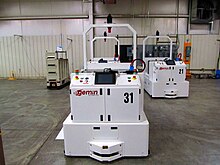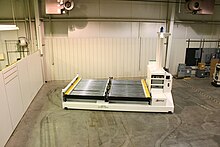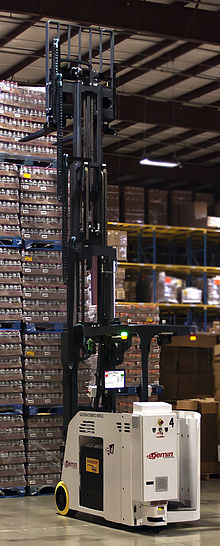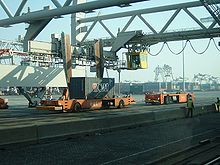An automated guided vehicle or automatic guided vehicle (AGV), also called autonomous mobile robot (AMR), is a portable robotly Sears Tower) in Chicago, Illinois to deliver mail throughout its offices.
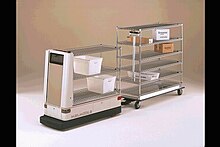
Geoguidance
A geoguided AGV recognizes its environment to establish its location. Without any infrastructure, the forklift equipped with geoguidance technology detects and identifies columns, racks and walls within the warehouse. Using these fixed references, it can position itself, in real time and determine its route. There are no limitations on distances to cover number of pick-up or drop-off locations. Routes are infinitely modifiable.
Steering control
To help an AGV navigate it can use three different steer control systems.[6] The differential speed control is the most common. In this method there are two independent drive wheels. Each drive is driven at different speeds in order to turn or the same speed to allow the AGV to go forwards or backwards. The AGV turns in a similar fashion to a tank. This method of steering is the simplest as it does not require additional steering motors and mechanism. More often than not, this is seen on an AGV that is used to transport and turn in tight spaces or when the AGV is working near machines. This setup for the wheels is not used in towing applications because the AGV would cause the trailer to jackknife when it turned.
The second type of steering used is steered wheel control AGV. This type of steering can be similar to a car's steering. But this is not very manoeuvrable. It is more common to use a three-wheeled vehicle similar to a conventional three wheeled forklift. The drive wheel is the turning wheel. It is more precise in following the programmed path than the differential speed controlled method. This type of AGV has smoother turning. Steered wheel control AGV can be used in all applications; unlike the differential controlled.[2] Steered wheel control is used for towing and can also at times have an operator control it.
The third type is a combination of differential and steered. Two independent steer/drive motors are placed on diagonal corners of the AGV and swivelling castors are placed on the other corners. It can turn like a car (rotating in an arc) in any direction. It can crab in any direction and it can drive in differential mode in any direction.
Path Decision
AGVs have to make decisions on path selection. This is done through different methods: frequency select mode (wired navigation only), and path select mode (wireless navigation only) or via a magnetic tape on the floor not only to guide the AGV but also to issue steering commands and speed commands.
Frequency select mode
collision avoidance sensors to avoid collisions with other AGV in the area. These sensors include: sonic, which work like radar; optical, which uses an infrared sensor; and bumper, physical contact sensor. Most AGV's are equipped with a bumper sensor of some sort as a fail-safe. Sonic sensors send a "chirp" or high frequency signal out and then wait for a reply from the outline of the reply the AGV can determine if an object is ahead of it and take the necessary actions to avoid collision.[8] The optical uses an infrared transmitter/receiver and sends an infrared signal which then gets reflected back; working on a similar concept as the sonic sensor. The problems with these are they can only protect the AGV from so many sides. They are relatively hard to install and work with as well.
Combination control
Combination control sensing is using collision avoidance sensors as well as the zone control sensors. The combination of the two helps to prevent collisions in any situation. For normal operation the zone control is used with the collision avoidance as a fail safe. For example, if the zone control system is down, the collision avoidance system would prevent the AGV from colliding.
System management
Industries with AGVs need to have some sort of control over the AGVs. There are three main ways to control the AGV: locator panel, CRT color graphics display, and central logging and report.[2]
A locator panel is a simple panel used to see which area the AGV is in. If the AGV is in one area for too long, it could mean it is stuck or broken down. CRT color graphics display shows real time where each vehicle is. It also gives a status of the AGV, its battery voltage, unique identifier, and can show blocked spots. Central logging used to keep track of the history of all the AGVs in the system. Central logging stores all the data and history from these vehicles which can be printed out for technical support or logged to check for up time.
AGV is a system often used in FMS to keep up, transport, and connect smaller subsystems into one large production unit. AGVs employ a lot of technology to ensure they do not hit one another and make sure they get to their destination. Loading and transportation of materials from one area to another is the main task of the AGV. AGV require a lot of money to get started with, but they do their jobs with high efficiency. In places such as Japan automation has increased and is now considered to be twice as efficient as factories in America. For a huge initial cost the total cost over time decreases. </ref needed>
Vehicle types
Towing Vehicles (also called "tugger" vehicles) were the first type introduced and are still a very popular type today. Towing vehicles can pull a multitude of trailer types and have capacities ranging from 2,000 pounds to 160,000 pounds.
AGVS Unit Load Vehicles are equipped with decks, which permit unit load transportation and often automatic load transfer. The decks can either be lift and lower type, powered or non-powered roller, chain or belt decks or custom decks with multiple compartments.
AGVS Pallet Trucks are designed to transport palletized loads to and from floor level; eliminating the need for fixed load stands.
AGVS Fork Truck has the ability to service loads both at floor level and on stands. In some cases these vehicles can also stack loads in rack. They can sometimes lift up to 30' to store or retrieve on high-bay racking.
AGVS Hybrid Vehicles are adapted from a standard man-aboard truck so that they can run fully automated or be driven by a fork truck driver. These can be used for trailer loading as well as moving materials around warehouses. Most often, they are equipped with forks, but can be customized to accommodate most load types.[9]
AGVs are used to move sea containers in some port container terminals. The main benefits are reduced labour costs and a more reliable (less variable) performance. This use of AGVs was pioneered in 1993 at the Port of Rotterdam in the Netherlands. By 2014 there were 20 automated or semi-automated port container termainals around the world which use either or both automated-guideway vehicles and automated-stacking-cranes.[17] The original AGVs used diesel power with either hydraulic or electric drives. However more AGV use battery power and automated battery swap, which reduces emissions and lowers refueling costs but cost more to purchase and have shorter range.[18]
Primary application industries
Efficient, cost effective movement of materials is an important, and common element in improving operations in many manufacturing plants and warehouses. Because automatic guided vehicles (AGVs) can deliver efficient, cost effective movement of materials, AGVs can be applied to various industries in standard or customized designs to best suit an industry's requirements. Industries currently utilizing AGVs include (but are not limited to):
Pharmaceutical
AGVs are a preferred method of moving materials in the pharmaceutical industry. Because an AGV system tracks all movement provided by the AGVs, it supports process validation and cGMP (current Good Manufacturing Practice).
<h3 style="margin: 0.3em 0px 0px; paddin





